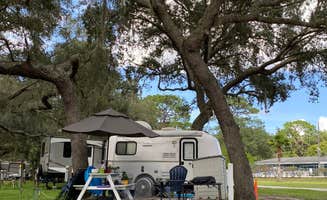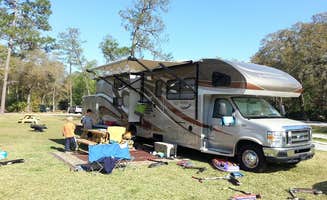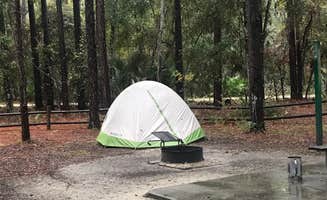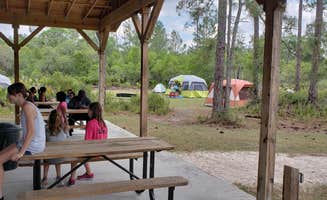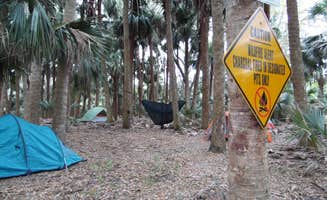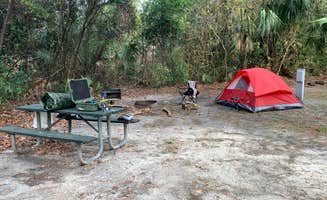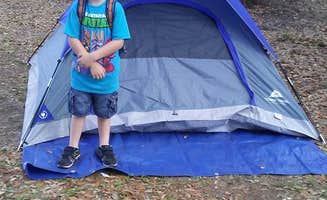Camping spots near Winter Park, Florida range from county-run facilities to state parks spanning a radius of 10-30 miles from the city center. Most campgrounds in this region sit at elevations under 100 feet, with terrain characterized by sandy soil and cypress forests. Average winter temperatures hover around 60°F during camping season, while summer humidity levels regularly exceed 80% during afternoon thunderstorms.
What to do
Tube down natural springs: At Kelly Park Campground, visitors can float down Rock Springs on inner tubes. "The park has multiple trails and the most beautiful natural lazy river. Tubbing is allowed in the River. Please note that you need to bring your own tube or there is a rental place before the park," explains Ilena R. The spring maintains a consistent 68-72°F temperature year-round.
Wildlife observation: Blue Spring State Park Campground offers prime wildlife viewing opportunities during winter months. "Kayaked the river, and even swam with manatees in the spring!!!" reports Anna C. The park features a 4.5-mile hiking trail where visitors can spot various Florida wildlife species in their natural habitat.
Biking trails: Moss Park Campground connects to several biking paths. "The park has some great walking trails as well. We stayed for 2 nights and really enjoyed this little piece of wilderness right in our own backyard," says Kelly. The park's location between lakes creates unique riding opportunities with water views on multiple sides.
What campers like
Privacy between sites: Campers appreciate the vegetative barriers at several campgrounds. At Wekiwa Springs State Park Campground, "The campground was quiet and the restrooms fairly clean. However, a weekday is best to visit the spring and river. On the weekend there were tons of people in the park," notes Jenn B. Most sites feature significant understory growth providing natural screening.
Clean facilities: Visitors consistently mention bathroom cleanliness as a plus. At Moss Park, one camper noted, "Clean bathrooms with hot showers. This is about 15 min from the airport yet very removed from Orlando. Water on three sides, gates that close and lock from 6pm to 8 am (Nov-March) but an easy access code is given at check in to be able to come and go after hours."
Unique wildlife encounters: Many campgrounds offer opportunities to see Florida's distinctive animals. "We had deer walking through our site each day at dusk. There were also giant sandhill cranes around. The park has some great walking trails as well," reports Kelly about her Moss Park experience. Morning and evening hours provide the best wildlife viewing conditions.
What you should know
Reservation windows vary: Most campgrounds open reservations 6-11 months in advance and fill quickly during peak season. For Magnolia Park Campground, "We have 6 kids, one in a wheelchair and a service dog and had an awesome time at this campground! Everyone was accommodated for!" notes Jeni S. Call specific parks for accessibility information and special accommodations.
Train noise affects some parks: Several campgrounds experience railroad noise. "The only bad part was the water smelled like sulfur. Kids still had a blast and we also hiked a little and found some sort of tower not far away. Great place to go on a hot day," mentions Christy C. about Wekiva Falls RV Resort, where background noise is present but rarely disrupts camping activities.
Early arrival recommended: Popular springs can reach capacity early, especially during summer months. "This is a great park with tons to do. Sites are well maintained. They are close, but there is a lot of vegetation in between. Bathrooms are spotless and cleaned 3x a day," reports Jenn B. about Blue Spring State Park. Some visitors line up before dawn during peak summer weekends.
Tips for camping with families
Playground access: Several parks offer dedicated play areas for children. "A short walk leads to a very nice playground with typical park equipment. My kiddos loved that playground. My favorite part was the springs that also had a little 'beach' where my youngest played in the sand after tubing," shares Shelly R. about Kelly Park. Most playgrounds are within walking distance of camping areas.
Safety considerations: Designated swimming areas provide safer options for families. At Blue Spring, "the springs are best to view and swim alongside between the winter months of November and February." The swimming areas are monitored during peak usage times.
Entertainment options: Lake Monroe Park offers multiple family-friendly amenities. "Small park with boat ramp, playground, and bike trails connecting to Gemini Springs," notes Diana F. The park's compact size makes it easier for families to keep track of children while still providing recreational variety.
Tips from RVers
Site leveling challenges: Many campgrounds have slightly uneven sites. "Great park for the money. Quite park that is very pretty and well maintained. Close to a lot to do in the area. Wild peacocks on site are cool to see. Sites are paved, with a good amount of privacy. Only complaint was our site was pretty unlevel and we had to max out our Anderson leveling blocks to get it right," advises Scott B. about Magnolia Park.
Water hookup locations: Placement of utilities can impact RV setup. "Water and electricity at each site. Convenient dump station. We were in site 2 and it was very nice. A small quiet campground," reports Norman S. about Lake Monroe Park. Most sites offer 30-50 amp electrical service, but amp availability varies by campground.
Maneuvering space: Site dimensions impact larger vehicles. "Sites were grassy in the area where we stayed. The main attraction was the swimming pool/spring in the center. Concrete borders surrounded it and there was a grassy hill to sun on or chairs to relax in too," notes Christy C. about Wekiva Falls RV Resort. Campground roads tend to be narrow with tight turns in older parks.


